Plug In Solar Panels: Will There Ever be a Tipping Point?
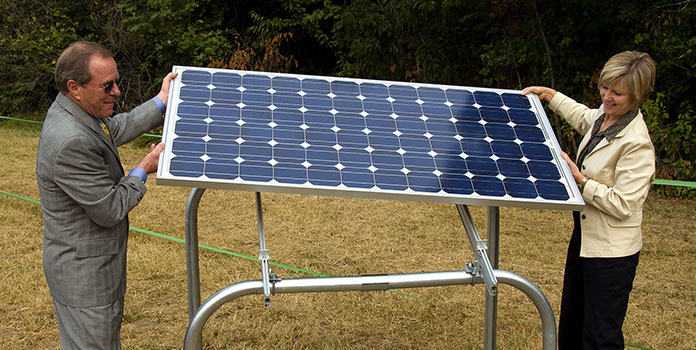
Will we ever get to a point of mass adoption?
For years now, many have pined for a plug and play solar installation. Something so easy and simple, you can just plug it in to any outlet and – boom! – you’ve added green energy to your home without ever even hiring a solar installer. Sounds incredible, but does it have wide enough appeal? And before we even get to mass adoption, can we get to the point where plug in solar panels and solar panel kits are a safe, legitimate option?
Why are plug in solar panels alluring?
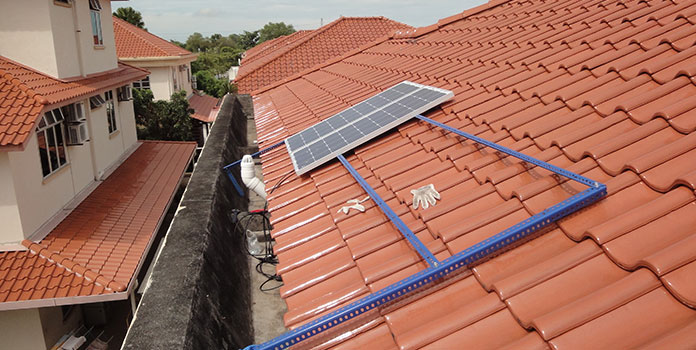
What’s the alluring part? Well, you theoretically don’t need an installer or electrician. Solar equipment like panels, inverters, and wire only account for about 40% of the total cost of a roof-top system according to a 2017 NREL study of solar costs (chart on page 21). If you can avoid hiring an installer, you can cut out 60% of the traditional cost of solar!
According to the same report, the average residential solar installation costs $2.80 per watt (same chart above). With an average installation size of 5,700 watts, that’s a total cost of $15,960, of which the equipment makes up about $6,400 (40%). Even if a plug and play system costs 2x as much as traditional equipment (including panels, mounting, inverter, wires, etc), it would still knock about $3k off the installation!
So if you’re able to cut out your installer, you drop your total investment by thousands of dollars, depending on the size of your installation of course. That seems like a pretty good incentive! On top of that, if you ever move, you can simply unplug your installation and bring it with you. The Smartflower, which has seen a boom in interest over the last year or so, advertises as just this: an easily portable, plug-in solar kit.
Sounds pretty appealing! But the question is: are plug in solar panels as easy as they sound? Let’s take a deeper look and see.
Does anyone make plug in solar kits?
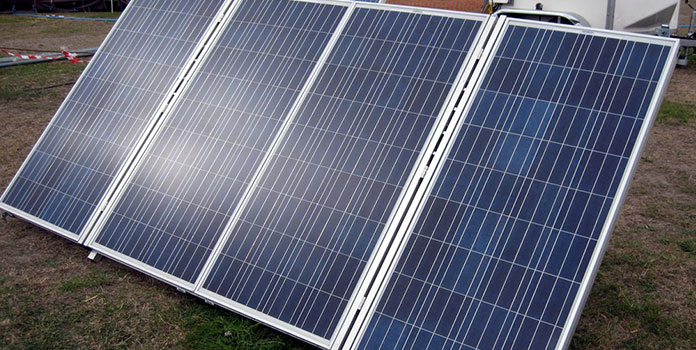
Actually, yes. You can go online and buy a plug and play solar kit from a few different companies, like the aptly-named Plug&PlaySolar. They sell small, single panel kits designed for both roof- and ground-mounting. For about $750, you can buy a 265 watt panel, microinverter, production monitor, roof mounting hardware, and 25’ of wiring that plugs directly into a 120v outlet. At $750, that’s a total cost of $2.83 per watt.
The ground-mount comes with a pre-made structure with 4 legs that can be bolted down and angled towards the sun. You can also buy ‘add on’ units for a discounted price to increase the size of your solar installation. While the entire kit isn’t UL listed, each individual component is (pg. 5), so you can rest assured these are all legitimate pieces of equipment that have been tested and deemed safe.
Another plug and play solar company, Plugged Solar, sells a larger array of kits, ranging from a single 250 watt panel to large 5,000 watt systems. Prices vary depending on size and inverter type. Prices (as of April 2018) for systems with microinverters (like the Plug&PlaySolar kit above) are listed at:
- $799 for a one-panel, 250 watt system (equal to $3.20 per watt)
- $2,495 for a 1,000 watt system ($2.49 per watt)
- $3,495 for a 1,500 watt system ($2.33 per watt and, amazingly, available on Amazon Prime)
- $7,990 for a 5,000 watt system ($1.60 per watt)
Kits include the solar panels, microinverters, mounting hardware, wires, safety disconnects (depending on size), production monitoring system, and a 240v plug. To put that more plainly, you’re getting solar panels with a microinverter attached, and the hardware to put the panels on your roof (or a ground mount for the 250 watt system).
At between $1.60 to $3.20 per watt for the equipment, are these kits a good deal?
To find out, let’s look back at that NREL report. They find that, for residential installations using microinverters, total equipment costs equaled $1.13 per watt (p. 21 of report). We don’t really need to say it, but this is much, much lower than the cost of the kits above.
Like we mentioned above though, with these DIY plug and play kits, you’re avoiding all the other costs that come with hiring a solar installer: labor, sales and marketing, their own profit, and overhead. Adding all these additional costs into the mix, the total installation cost for a microinverter-based system adds up to $3.13 per watt.
So even though the actual equipment costs are much higher than when purchased through an installer, the kits above can actually save you quite a bit of money when you do it yourself!
Let’s consider what that means for a 5kW installation (a fairly average size for a residential system):
| Comparison of Installation Costs of a Conventional 5kW Solar System and Plugged Solar 5kW Kit (with microinverters) | |||
| Installation Type | System Size | $/Watt Cost | Total Cost |
| Hire an Installer | 5 kW | $3.13 | $15,650 |
| Plug and Play | 5 kW | $1.60 | $7,990 |
By buying the Plugged Solar Kit and installing it yourself, you could potentially save $7,660, or about 50% of what you’d otherwise spend. That’s pretty tempting, huh?
Most of us, however, probably aren’t interested in putting up a giant 5kW plug and play kit. Instead, you’re probably interested in a panel or two. You should know, though, that a single solar panel isn’t going to make much of a dent in your bills.
In sunny Arizona, one of the best places in the US to install solar, a 265 watt panel facing south will produce about 460 kWh each year. As of this writing, the national average electricity price of $0.125 per watt means that you save $55 per year. So that $800 single-panel kit would take almost 15 years to pay off – not really worth it, is it?
Of course, the larger you go, the lower the $/watt cost and the more you could save!
Now that we’ve run through how you can buy plug and play solar, what it costs and how much you can save, we’ll discuss why they are so different from traditional panels.
How does plug in solar work?
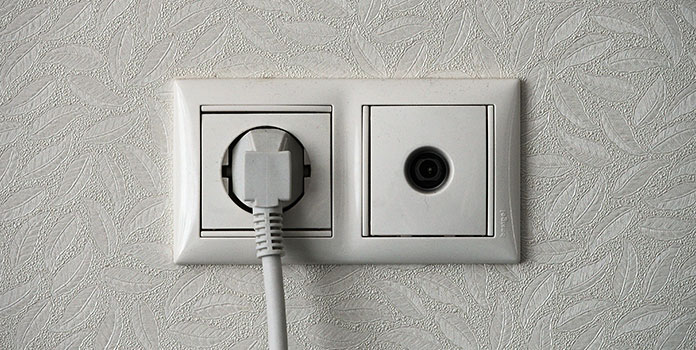
The beauty of plug and play solar is in its simplicity. Basically, you put the panel in the sun and plug it into an outlet. Done.
A typical residential solar installation is pretty straightforward, but more complicated than the above to be sure. Instead of going directly into your wall outlet, electricity moves from the panels through a series of safety disconnects and your inverter to your electrical panel, typically via a dedicated breaker.
These disconnects and the breaker allow workers to isolate certain parts of the system for maintenance and repair, and help protect the system from overheating and fire. The inverter is designed to shut down if the electrical grid goes down, known as ‘anti-islanding’. That is pretty important, as it ensures that there is no ‘rogue’ electricity unknowingly being added to the grid while line workers are completing repairs on electric distribution lines.
All this brings us to a major issue with plug and play solar. Without the same safety features as a traditional rooftop installation, are you going to set your house on fire or electrocute someone if you use them?
Are plug in solar panels safe enough to use?
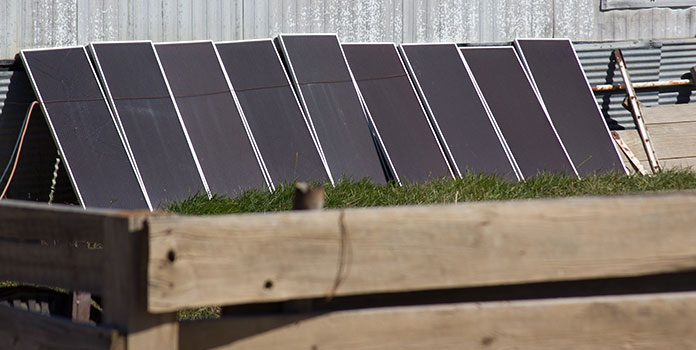
Can you legally – and safely – just plug some solar panels in a standard home outlet to provide power? The answer isn’t entirely straightforward.
To set the record straight, plug and play solar shouldn’t be some rogue op to stealthily cut your electricity bill. Just like with a traditional solar installation, you’ll be adding electricity to the grid so you’ll need to seek approval from the necessary authorities, typically your local building department and utility.
Part of this approval process is to make sure everything is up to code, as set forth in the International Building Code and the National Electric Code. In a sentence, the IBC is designed to keep your house from falling down on you or a neighbor, and the NEC is designed to keep your house from going up in flames. Both very noble aspirations, if you ask us.
So where’s the problem with plug and play solar? It’s in the code. And as we see it, it’s two-fold:
No Dedicated Wiring
First, solar installations require a dedicated line going to your electrical panel. This is a safety standard – a way to ensure that the wiring can safely handle all the power your panels are putting out. When you hire a company to put a conventional solar system on your roof, dedicated wires are installed to connect the panels to your inverter – completely separate from your home’s existing wiring.
These wires are sized to handle the max amount of electricity your system can produce. All connections are hardwired, meaning they are semi-permanent connections, not simply plugs that could easily fall or be pulled out.
Obviously, plug and play kits have dedicated lines coming from the panels to the electrical outlet, but not necessarily from the outlet to the electrical panel.
However, just like a traditional solar installation, plug and play solar requires an isolated electrical circuit to provide a similar level of safety. So, to create a dedicated circuit for your solar installation, nothing else can be powered using that same circuit. Plug&PlaySolar notes this requirement in their installation instructions (pg. 5):
“The outdoor outlet used to plug in the Plug and Play Solar kit(s) MUST be a dedicated outlet on its own dedicated 15A or 20A circuit. This dedicated circuit and outlet should be installed by qualified and/or licensed personnel only. No other loads or outlets are allowed on this dedicated solar circuit!”
But here’s the issue that your local building department might have. Yes, you have it connected on its own circuit during the inspection, but what about when you want to set up your holiday lights or have a party in your yard and the only available outlet is the one your panels are plugged into? The inspector can’t be there all the time to make sure you’re following the guidelines.
You could alleviate this issue by semi-permanently hardwiring your solar installation into your dedicated circuit, but then it’s not really plug and play solar, is it?
Another question to ask yourself: what do you know about the wiring in your house? Your existing wiring can probably handle a single panel or two, but individual circuits aren’t designed to handle high volume, constant electricity. What about the 1.5kW, or even the 5kW, system we mentioned above?
Responding to comments on a publicity article a few years back, Plug&PlaySolar claimed that most home wiring in the US can handle up to 2kW of electricity (which coincides with capacity of 12/2 Romex wiring common in homes), so a 1.5kW system would be fine on a dedicated circuit.
However, this doesn’t alleviate the issue that the system still isn’t hardwired, and in fact exacerbates the problem if you ever added more gadgets to the circuit. If that ever happened with a 1.5 kW solar system pumping out electricity on full blast, things could get smoky real fast. And a 5kW kit? Don’t even think about it. The average home could never handle it.
Even so, Plug&PlaySolar claimed in their comments on that same piece above that their kits have been approved for use in 23 different states, so there’s some hope you could legally install it. However, they still strongly warn that regulations vary from place to place, and just because your state is one of them doesn’t guarantee approval in your specific area.
Safe Panel Mounting
Issue #2 revolves around safely securing your solar panels. Conventional solar installations are bolted to your roof with a series of aluminum rails, feet, flashing, sealant, and lag screws. The size and depth of the lag screws depend on the weight of the system, the size of the roof rafters, and the type of wood the rafters are made from.
Making any kind of holes on the roof to secure the panels with all that stuff requires waterproofing. Sealing your penetrations is a straightforward process, but needs to be learned in order to do it properly. Otherwise you’ll have unprotected holes through your roof, guaranteeing water damage down the line.
All of this is standard stuff for the average solar engineer, but most of us don’t have the training to do it ourselves. And these are the kinds of things that your building department will inspect before approving your installation. You do it wrong and you set yourself up for a lot of problems in addition to failing the inspection.
If you’ve got a single solar panel, you could easily make a small stand and put it in your backyard without too much trouble. But if you’re talking 4, 8, or even 20 panels (in a 5kW system), installation takes planning, knowledge, and skill. It’s certainly doable for a DIYer, but you’ll need to really study up to ensure the safety of your family and your home, as well as your neighbors.
The issue likely won’t be with the utility – who really only cares that the electricity you’re sending to the grid is safe and compatible with their grid, but your building department, as they’re more concerned with the safety and integrity of your home. If you’re really interested in plug and play solar, reach out to both organizations before buying your system, so you know exactly what they require – each utility/building department is unique!
How’s the future look for plug and play solar?
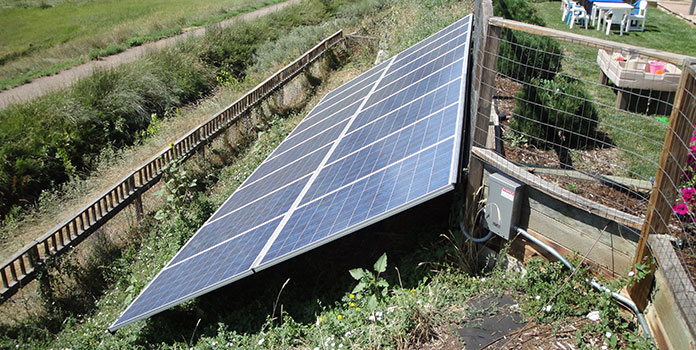
Plug and play solar is certainly doable. Even now, with inverters that automatically switch off when the grid goes down, you could install a system that operates safely and that you simply plug into an outlet.
However, you’d need a dedicated circuit with no other appliances using that wiring – and this is something that simply cannot be guaranteed – you can’t have an inspector come around every afternoon just to check you haven’t moved your TV!
As technology gets better, safety measures improve, and installations get more streamlined, perhaps more people will opt in. Every 5 years or so, some new company comes along promising to change the way solar is installed. They always have a new, ultra-safe and convenient plug in system that revolutionize the industry. We all get excited, then years later we are still installing panels the traditional way.
If you really wanted to go all out, you could install a dedicated line that is hardwired to your solar installation, but there’s the irony: we’ve just described a conventional residential solar installation.
Do you agree or disagree with our analysis of plug and play solar? Let us know in the comments below. We’d love to hear your views!
Photo Credits under CC license via Flickr – 1, 2, 3, 4, 5, 6.
